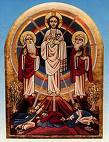From Christ in the Desert
I am blogging from Christ in the Desert this week, where I am making a fraternal visit. One of my hopes for the week is simply to spend more time in prayer than my usual schedule allows. This desire is prompted in large part (aside from my usual desire to spend time in prayer!) by our new change in schedule. After one week of the new schedule, I personally find it very refreshing.
The change of time for Mass on weekdays has caused some mild consternation among some friends, a result that we had anticipated. For sixteen years, we had offered Mass in the evening, following the model of urban monasticism pioneered by the Community of Jerusalem. The general inspiration is actually close to that of Dom Prosper Gueranger, the Wolter brothers at Beuron, and other nineteenth-century monastic reformers. In that era, the fallout from the French Revolution and the Industrial Revolution left parish life in the cities in a kind of stupor. Gueranger in particular wished to offer to the laborer a vision of hope through the celebration of beautiful liturgy. Similarly, in modern secularized France, the monastic Fraternity of Jerusalem has crafted a schedule of prayer that allows many people to participate. Furthermore, instead of Gregorian chant, which The Abbey of Solesmes offered as part of their vision, Jerusalem offers a blend of Western hymnody and Eastern homophonic chant. The result is a remarkable attendance and participation by the faithful, even in the middle of agnostic Paris. (A more familiar example of a similar experiment would be Taize.)
We attempted that model in Chicago for about nine years. We found that some adjustments needed making. For one thing, what works in the cultural climate of Paris doesn't necessarily translate to Chicago. By comparison to France, Chicago's Catholic culture is strong and vibrant, and the need for invigoration by a charismatic monastic community is rather less pressing. The ethnic diversity of Chicago also means that the Frenchy sort of music that we had brought had less appeal to broad areas of Chicago's Catholic population. Bridgeport is off the beaten path, unlike St. Gervais.
For these reasons and many others, the community eventually became part of the Benedictine Congregation of Subiaco. However, while making this change, we kept many aspects of the Jerusalem ideal, especially aiming at accomodating the city schedule with our prayer schedule. Truth be told, we have never been able to attract big crowds, even though I believe that our liturgy is quite prayerful and beautiful. So we finally decided to make the switch to the more traditional Benedictine arrangement of Mass in the morning and the main meal at midday.
This, however, leaves us with a new challenge. We had been following a certain type of spirituality and operating with a set of goals inherited from Jerusalem. Among these was an earnest desire to make accomodations to the city for the sake of the city. These goals are no longer truly applicable. We are still a monastery in a city, and we were invited by Cardinal Bernadin specifically to offer our witness in the city. We are now being asked by God to re-envision our charism. It is this re-envisioning that I hope to engage in throughout this week. There are many indications of the work of the Holy Spirit in our lives, and I know that this work will continue to change. Therefore, a newly formulated charism would not be meant to be something restricting or something that can be articulated once and for all. However, I do sense that this is a time of grace for our community to add a new joy and purpose to our life together. So I ask for your prayers as we continue on our pilgrimage as monks.
God's blessings to you!

No comments:
Post a Comment